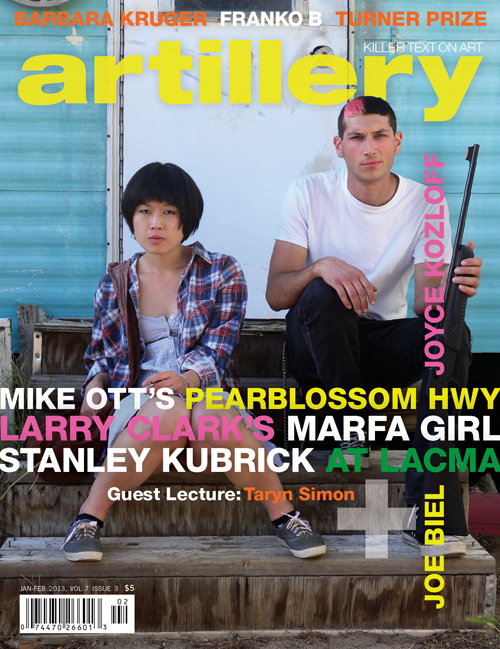Dear Readers,
 In this issue of Artillery we’re featuring three stories on film. To tell you the truth, it wasn’t planned that way, but things just fell into place. Oddly enough, the three filmmakers represent a microcosm of hierarchical filmmaking. From acclaimed director Stanley Kubrick to indie filmmaker riding the crest, Mike Ott, with Larry Clark in the middle, a rebel artist finally getting his due with Best Film at the Rome Film Festival.
In this issue of Artillery we’re featuring three stories on film. To tell you the truth, it wasn’t planned that way, but things just fell into place. Oddly enough, the three filmmakers represent a microcosm of hierarchical filmmaking. From acclaimed director Stanley Kubrick to indie filmmaker riding the crest, Mike Ott, with Larry Clark in the middle, a rebel artist finally getting his due with Best Film at the Rome Film Festival.
To give you a glimpse into the editorial world at Artillery, everything was filed and ready to go to the designer when I woke up to a string of emails congratulating Larry Clark for his triumph in Rome. I went straight to YouTube and watched his acceptance speech. Our contributor Luca Celada happened to be in Italy, and yes, he did attend the festival awards, and yes he did in fact see Clark’s film, Marfa Girl. What luck! And such an extra bonus that Luca can interpret the Italian translator, euphemizing her way around all of Clark’s profanity. Hilarious.
But wait. This is an art magazine! You might ask why do we have three articles about film? Actually, we’ve been writing about film since our first volume. Our regular column about esoteric DVDs on the current market, Bunker Vision by Skot Armstrong, has been in the magazine from day one. And we had a Film & Art issue during our first year.
Most artists and art-lovers are very much into the cinema and probably secretly dream about making their own films. An artist who works with the camera often fantasizes about putting all those pictures together to make a movie. It’s a very natural progression. And that has been Clark’s experience, since he first made an impact with Tulsa, his seminal book of gritty black-and-white photography, in 1971. Artists who combine imagery with narrative are natural candidates for having some kind of film in their repertoire—at the very least, one black-and-white Super 8 short.
Clearly, filmmaking is part of the “art” world. Many visual artists have worked in film: Mike Kelley, Paul McCarthy, Sharon Lockhart and Marnie Weber are a few LA artists that come to mind. But their films fall more into the category of experimental filmmaking with a very loose or nonexistent narrative. In other words, these films are not hot prospects for success in the commercial movie industry. Nevertheless, they are artists making films.
That said, the film industry per se doesn’t really interest me as material for Artillery. But here we are in Hollywood, and it just sort of creeps into the art world. We all wish Hollywood would pay a little more attention to the artists out there (as in taking advantage of—and paying for—the preeminent art Los Angeles has to offer). It’s pretty obvious how very little the film world knows or cares about how the art world really works. We see evidence of this whenever a movie attempts to portray an artist or the gallery system.
But the three film stories in this issue are about filmmakers who are artists with unique visions and aesthetics. And whether you’re making a film, writing a book, directing a TV sitcom or telling a joke, if it’s any good, if it’s creative, if it’s something you’ve never seen before, then it’s probably art. And that’s why it’s in Artillery.


